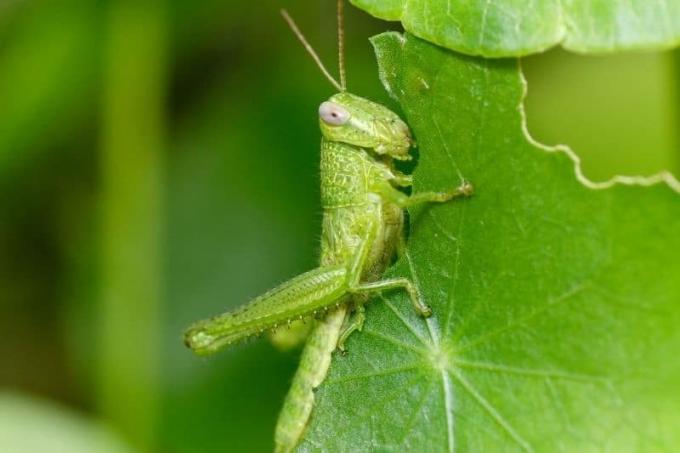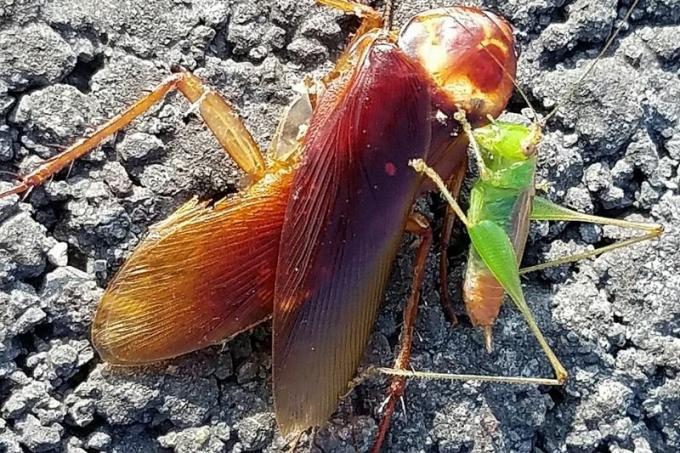
Grasshoppers differ not only in their appearance, but also in their feeding habits. In some species, animal components are also on the menu in addition to plant components. That's what grasshoppers eat.
In a nutshell
- Grasshoppers prefer green areas for camouflage and protection from predators
- eat meanwhile omnivorous, i. H. both vegetable and animal
- Sweet grasses and small insects are particularly popular
- changed diet results from changed living conditions
Table of Contents
- appearance and lifestyle
- This is how grasshoppers eat
- Vegetable food
- animal food
- frequently asked Questions
appearance and lifestyle
Grasshoppers (Gomphocerinae) are mostly known for their distinctive chirping. They are predominantly light green to brownish in color, because coloring provides them with natural camouflage. In almost all green areas they have protection against predators. Other features are:
- 15 to 22 millimeters in size
- thin pairs of antennae
- short front legs and long and strong hind legs
- Males are usually smaller than females
The insect is mainly found in meadows and shrubs. These serve as a retreat and at the same time as food to eat. To be able to move well, plants with a height between 30 and 80 centimeters are preferred. The grasshopper family includes around 26,000 different subspecies. However, not all of them are represented in Germany or Europe.

A notice: The chirping of the grasshoppers is primarily used to search for a partner animal. In addition, the sounds are also used to defend their own territory and to warn of predators.
This is how grasshoppers eat
Originally, the grasshopper was a purely herbivorous species. Due to various external influences, however, the genera continued to develop into omnivores (all-eaters). The eating behavior is characterized by both plant and animal parts.
The main reason for the omnivorous lifestyle of locusts is the decline in natural habitats. Due to the clearing of forests and meadows, the center of life of the grasshopper is disappearing. The areas characterized by intensive agriculture therefore no longer offer the insect adequate retreat and food procurement options.

In addition, behavior is influenced by various additional factors:
- presence of predators
- mobility
- population size
- Availability of nutrients and minerals
A notice: Despite the adaptation of the feeding behavior, the locust population is severely threatened. All native species have therefore been on the red list of endangered creatures since 2019.
Vegetable food
The plant-based diet is the basis of the daily diet for most species. Grasshoppers particularly like to eat the following plant species:
- berry plants: blackberry, raspberry, strawberries
- Fruits: apple, pear
- Herbs: wild garlic, dill, coriander, cress, Parsely
- dandelion
- Sedges (subspecies of sour grasses): sedges, sedge
- Sweet grasses: bamboo, feather grass, moor grass, reed, fescue

In terms of plant food sources, the focus of hay horses is on sweet grasses. In addition to the aforementioned species, these include many useful plants such as wheat, corn, millet and oats. When larger swarms appear, there is a risk that the plants will be completely eaten away.
Tip: In order to prevent an unwanted plague, it is advisable to settle natural predators in your own garden. In addition to birds, wasps also belong mice, martens and rats are natural enemies.
animal food
For a balanced supply of nutrients, many species now also rely on animal foods. Some known sources of local species are:
- conspecifics
- aphids
- To fly
- larvae
- leaf miners
- caterpillars

Individual varieties also feed on the carrion of larger animals. In addition to animals that have already died, the grasshopper mainly feeds on sick or injured creatures.
frequently asked Questions
Although the hay horse eats a wide range of pests, it is not suitable as a pest controller. In addition to aphids and leaf miners, many beneficial insects such as caterpillars and worms are among the preferred foods. The settlement of a large swarm would therefore also go hand in hand with a reduced population of the desired insects.
As a rule, gardens and parks kept in a natural way offer an adequate supply of food. In addition to various plant species, the grasshopper will also find a whole range of different insect species here.
In addition to providing sufficient hiding places and food, the use of an insect drinker is also recommended. This not only serves as a water source for the hay horses, but also for many other insects.



